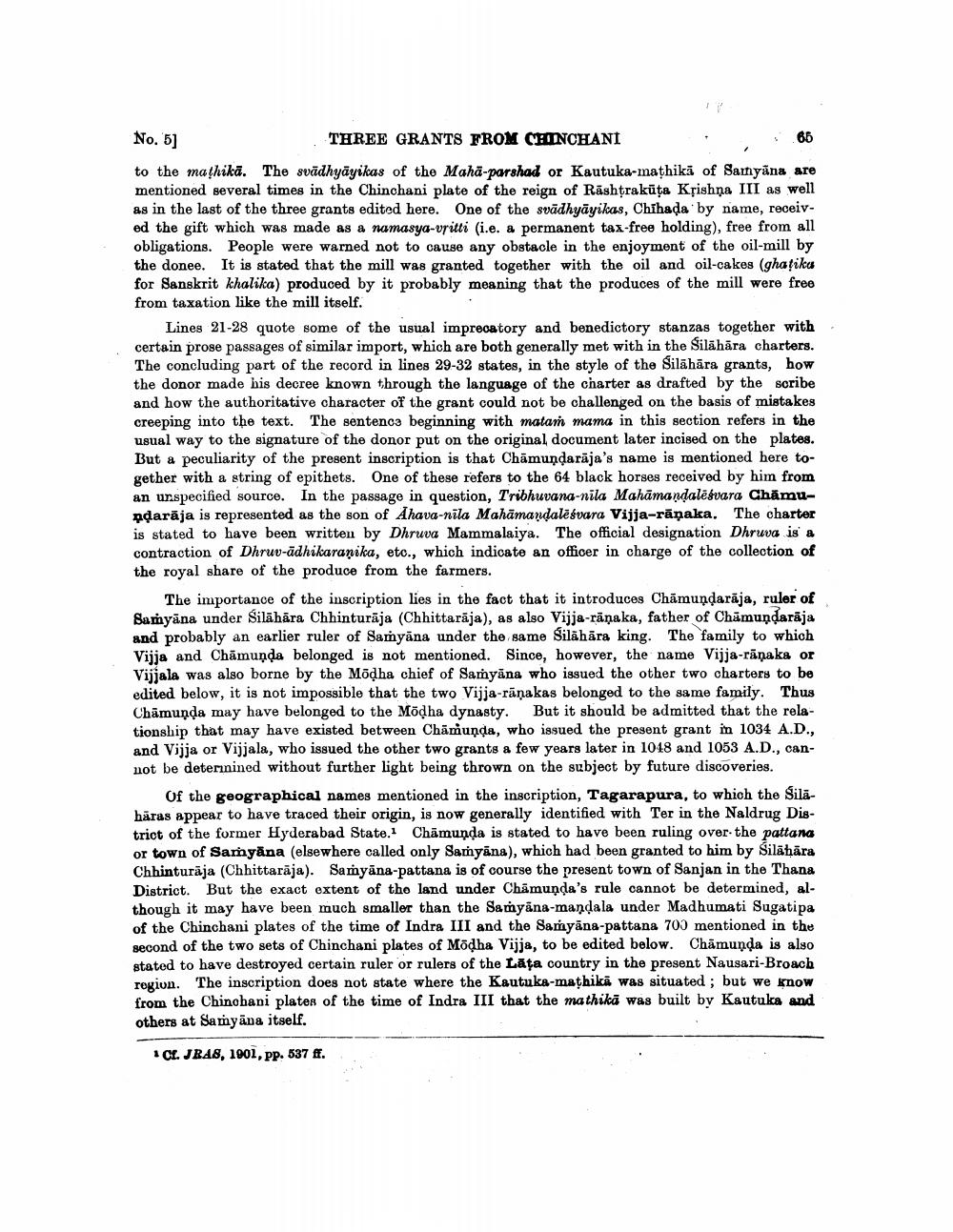________________
65
No. 5]
THREE GRANTS FROM CHINCHANI
to the mathika. The svadhyayikas of the Maha-parshad or Kautuka-maṭhika of Samyana are mentioned several times in the Chinchani plate of the reign of Rashtrakuta Krishna III as well as in the last of the three grants edited here. One of the svadhyayikas, Chihada by name, received the gift which was made as a namasya-vritti (i.e. a permanent tax-free holding), free from all obligations. People were warned not to cause any obstacle in the enjoyment of the oil-mill by the donee. It is stated that the mill was granted together with the oil and oil-cakes (ghatika for Sanskrit khalika) produced by it probably meaning that the produces of the mill were free from taxation like the mill itself.
Lines 21-28 quote some of the usual imprecatory and benedictory stanzas together with certain prose passages of similar import, which are both generally met with in the Silahāra charters. The concluding part of the record in lines 29-32 states, in the style of the Silahara grants, how the donor made his decree known through the language of the charter as drafted by the scribe and how the authoritative character of the grant could not be challenged on the basis of mistakes creeping into the text. The sentence beginning with matam mama in this section refers in the usual way to the signature of the donor put on the original document later incised on the plates. But a peculiarity of the present inscription is that Chamuṇḍaraja's name is mentioned here together with a string of epithets. One of these refers to the 64 black horses received by him from an unspecified source. In the passage in question, Tribhuvana-nila Mahamandalesvara Chamunḍarāja is represented as the son of Ahava-nila Mahamaṇḍalēśvara Vijja-rāņaka. The charter is stated to have been written by Dhruva Mammalaiya. The official designation Dhruva is a contraction of Dhruv-adhikaranika, etc., which indicate an officer in charge of the collection of the royal share of the produce from the farmers.
The importance of the inscription lies in the fact that it introduces Chamuṇḍaraja, ruler of Samyāna under Silahāra Chhinturaja (Chhittarāja), as also Vijja-ranaka, father of Chamunḍarāja and probably an earlier ruler of Samyana under the same Silahāra king. The family to which Vijja and Chamunda belonged is not mentioned. Since, however, the name Vijja-rāņaka or Vijjala was also borne by the Mōdha chief of Samyana who issued the other two charters to be edited below, it is not impossible that the two Vijja-ranakas belonged to the same family. Thus Chamunda may have belonged to the Mōdha dynasty. But it should be admitted that the relationship that may have existed between Chamunda, who issued the present grant in 1034 A.D., and Vijja or Vijjala, who issued the other two grants a few years later in 1048 and 1053 A.D., cannot be determined without further light being thrown on the subject by future discoveries.
Of the geographical names mentioned in the inscription, Tagarapura, to which the Silahāras appear to have traced their origin, is now generally identified with Ter in the Naldrug District of the former Hyderabad State.1 Chamunda is stated to have been ruling over the pattana or town of Samyana (elsewhere called only Samyana), which had been granted to him by Silähära Chhinturaja (Chhittarāja). Samyana-pattana is of course the present town of Sanjan in the Thana District. But the exact extent of the land under Chamunda's rule cannot be determined, although it may have been much smaller than the Samyana-maṇḍala under Madhumati Sugatipa of the Chinchani plates of the time of Indra III and the Samyana-pattana 700 mentioned in the second of the two sets of Chinchani plates of Mōdha Vijja, to be edited below. Chamunda is also stated to have destroyed certain ruler or rulers of the Lața country in the present Nausari-Broach region. The inscription does not state where the Kautuka-mathika was situated; but we know from the Chinchani plates of the time of Indra III that the mathika was built by Kautuka and others at Samyana itself.
1 CL. JRAS, 1901, pp. 537 ff.




